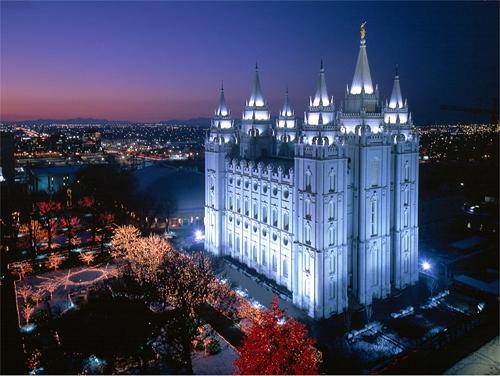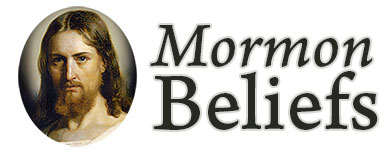 The center of Mormon worship (that of The Church of Jesus Christ of Latter-day Saints) is Jesus Christ. The Prophet Joseph Smith said, when he was asked about the fundamental principles of Mormons, “The fundamental principles of our religion are the testimony of the Apostles and the Prophets, concerning Jesus Christ, that He died, was buried, and rose again the third day, and ascended into heaven; and all other things which pertain to our religion are only appendages to it” (Teachings of the Prophet Joseph Smith, p. 121).
The center of Mormon worship (that of The Church of Jesus Christ of Latter-day Saints) is Jesus Christ. The Prophet Joseph Smith said, when he was asked about the fundamental principles of Mormons, “The fundamental principles of our religion are the testimony of the Apostles and the Prophets, concerning Jesus Christ, that He died, was buried, and rose again the third day, and ascended into heaven; and all other things which pertain to our religion are only appendages to it” (Teachings of the Prophet Joseph Smith, p. 121).
Truly Jesus’ mission, culminating in His Atonement, is the most important message of Mormonism.
The center of religiosity in the Mormon Church is the home and family. Mormonism is not a religion of outward ritual only, but is imbued with spirituality with a connection to deity available through the companionship of the Holy Ghost. That spirituality and spiritual connection is certainly sensed during Sunday worship, and especially experienced in the Temple, but becomes a central aspect of daily life in the home. Mormons engage in family and individual prayer, hold Family Home Evening weekly, read and discuss the scriptures together, teach the doctrines of the kingdom, reinforce belief through spiritual experiences, fast together to help the sick and solve difficult problems, and celebrate spiritual milestones (temple marriages, births, missionary departures and returns, etc.). The home teaching and visiting teaching programs of the Church send out representatives from the ward (parish) to homes on a monthly basis to be sure all is well and offer any needed help. All the programs of the Church are meant to strengthen families.
Sabbath Worship
In Christian countries, Mormons meet on Sundays, and that has been the tradition of the Church since its founding. However, in countries with majority Jewish or Muslim populations, branches of the Church meet on the day of the week usually reserved for worship in that culture. The branches in Israel meet on Saturday, and branches in Egypt meet on Friday. This pattern keeps the spirit of the law—to rest and worship on the seventh day—but enables Latter-day Saints to fit into the work week of the culture in which they reside.
The central goal of Sabbath worship for Mormons is to partake of the sacrament, representing the body and blood of Christ. Thus, the main Sunday meeting is Sacrament Meeting, which is scheduled for 70 minutes. Typically, the sacrament consists of bread and water. (To read the blessings on the sacrament, click here.) A hymn is sung, and then the sacrament is passed to the congregation. The sacramental covenants renew Mormons’ covenants made at baptism: to take upon oneself the name of Christ, to always remember Him, to keep His commandments, and to witness of Him. The remainder of the meeting is usually filled with “talks” (sermons delivered by congregants upon the previous request of the bishopric). Monthly, a talk is delivered by a representative of the “stake” (a group of parishes). The rest of the sacrament meeting consists of the singing of hymns, prayers, the bearing of testimonies, and presentations by the choir.
Two other sabbath meetings are held in conjunction with sacrament meeting: Sunday School and Priesthood/ Relief Society. The meetings altogether with sacrament meeting take 3 hours. There are also special meetings for youth and children, plus a nursery with instruction for toddlers 18 months through 3 years of age.
Sabbath meetings are held in Mormon meeting houses, and anyone may attend, regardless of faith. Mormon meeting houses are simple structures with a chapel, cultural hall, offices, and classrooms. There are no icons in Mormon chapels. Mormons worship the living Christ, so there are no crucifixes anywhere in the meeting house. Artwork depicting events in the Savior’s life are common throughout the meeting house.
Temple Worship
 Temple worship takes one’s religious experience to another level. The temple is the Lord’s house, and His spirit is strongly felt there. Mormons go to the temple to make and renew covenants, to pray and meditate, and to do work for the dead (see Temples Do). Only Mormons in good standing and who hold a temple recommend may attend the temple (see Temples Who). The blessings of temple worship are so great that the Church is endeavoring to build temples in greater numbers all over the world to facilitate access for all. Temples are open very early each morning (most are closed on Sundays, Mondays, and holidays) until about eight at night, though a few sponsor late-night sessions. Saints may attend whenever they desire, and may make advance arrangements for weddings, baptism sessions, and work done in groups.
Temple worship takes one’s religious experience to another level. The temple is the Lord’s house, and His spirit is strongly felt there. Mormons go to the temple to make and renew covenants, to pray and meditate, and to do work for the dead (see Temples Do). Only Mormons in good standing and who hold a temple recommend may attend the temple (see Temples Who). The blessings of temple worship are so great that the Church is endeavoring to build temples in greater numbers all over the world to facilitate access for all. Temples are open very early each morning (most are closed on Sundays, Mondays, and holidays) until about eight at night, though a few sponsor late-night sessions. Saints may attend whenever they desire, and may make advance arrangements for weddings, baptism sessions, and work done in groups.
Conferences
Special conferences are held on the ward, stake, area, and general church level. Twice each year, the general conference of the Church is held at the Conference Center in Salt Lake City, Utah, and broadcast throughout the world. Two two-hour sessions are held on Saturday, with a special two-hour priesthood session at night. Two two-hour sessions are held on Sunday. General Conference is held on the first weekend of October and the first weekend of April. Sessions are available on the internet at lds.org.
Mormons love music and song. Special presentations are arranged for Christmas and Easter, and for Pioneer Day (celebrating the day the Mormon pioneers reached the Salt Lake Valley). The Mormon Tabernacle Choir performs at conferences and special occasions. They present open rehearsals in Salt Lake City on Thursday nights, and guests may sit in for Music and the Spoken Word on Sunday mornings. The Choir presents special performances at Temple Square at Christmas, as well.
